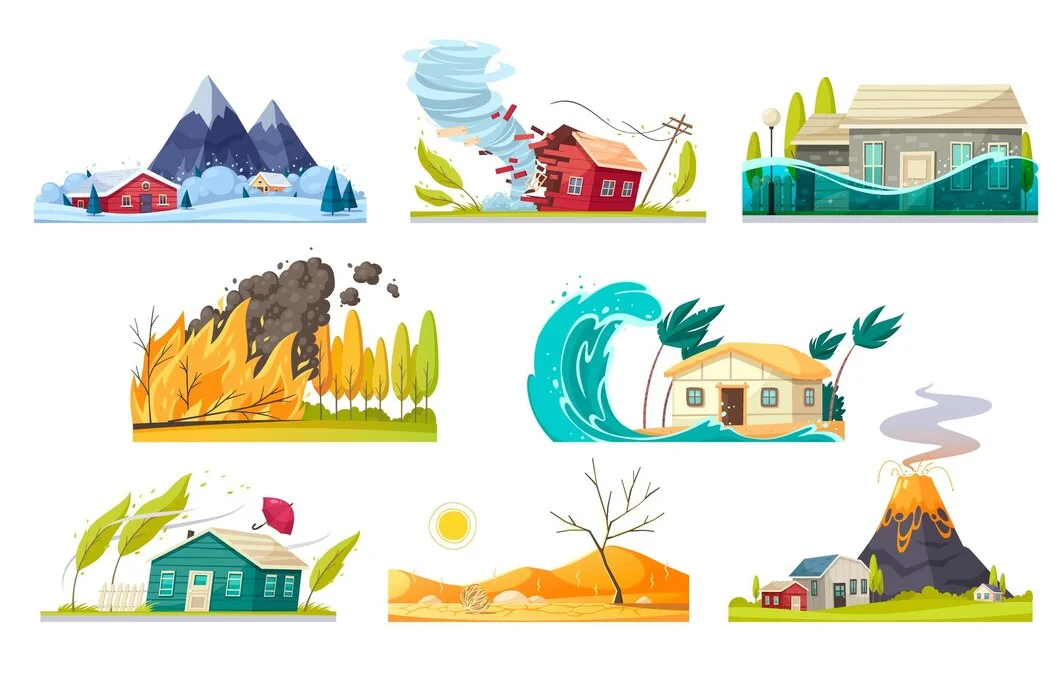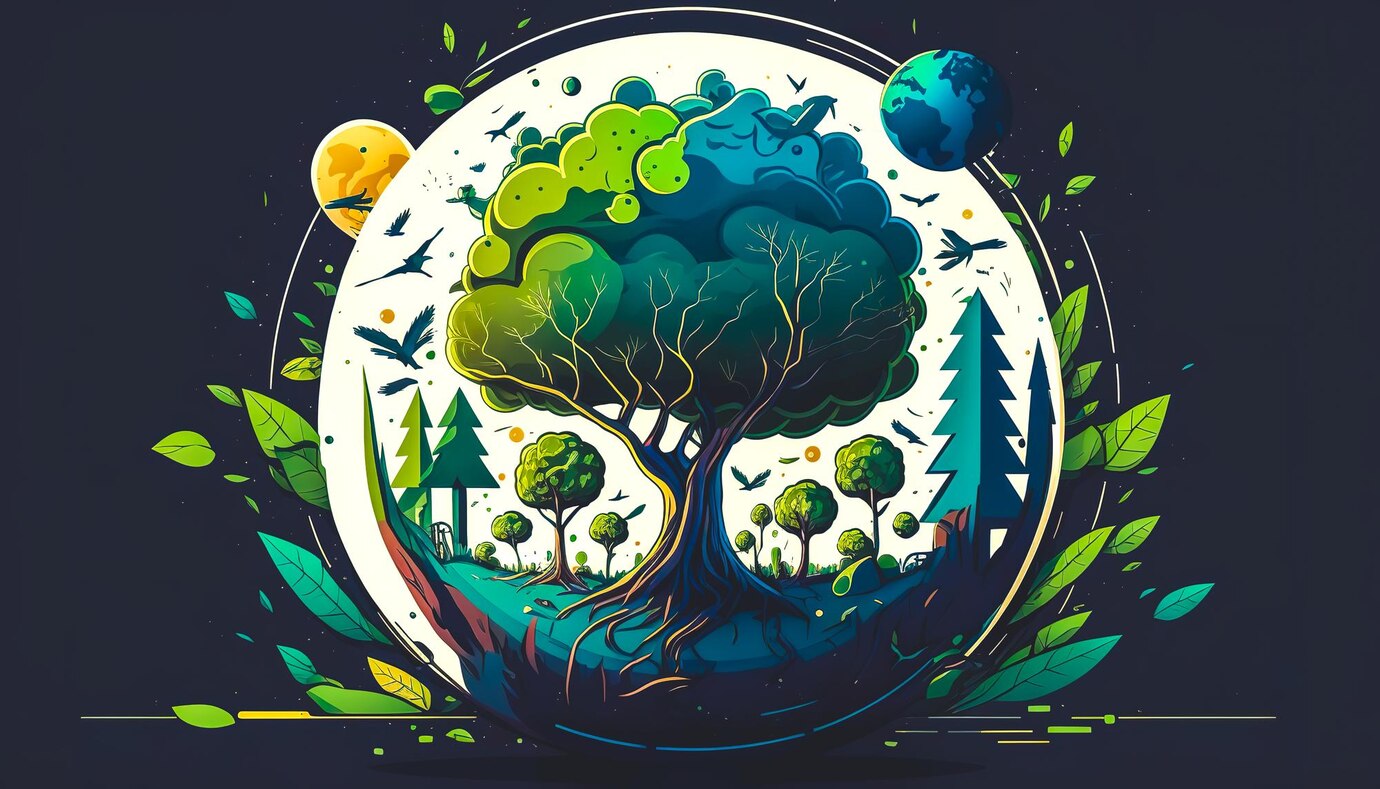Environmental degradation is the deterioration of the environment through depletion of resources which includes all the biotic and a biotic elements that form our surroundings that is air, water, soil, plant animals, and all other living and non-living element of the planet of earth. The major factor of environmental degradation is human (modern urbanization, industrialization, over population growth, deforestation, etc.) and natural (flood, typhoons, droughts, rising temperatures, fires, etc.) cause. Today, different kinds of human activities are the main reasons for environmental degradation.

Hazards and Disaster
Disaster, as defined by the United Nations, A disaster is a serious disruption to the functioning of a community, which causes human, material, economic and environmental losses beyond a community’s ability to cope. It results from the combination of hazards, conditions of vulnerability, and insufficient capacity or measures to reduce the potential negative consequences of risk.
(VULNERABILITY + HAZARD) / CAPACITY = DISASTER
Disaster damage occurs during and immediately after the disaster. This is usually measured in physical units (e.g., square meters of housing, kilometers of roads, etc.) and describes the total or partial destruction of physical assets.
Disaster impact is the total effect, including negative effects (e.g., economic losses) and positive effects (e.g., economic gains), of a hazardous event or a disaster. The term includes economic, human, and environmental impacts, and may include death, injuries, disease, and other negative effects on human physical, mental, and social well-being.
Difference between Hazard and Disaster: The main difference between hazard and disaster is that hazard is a dangerous situation or event that poses a threat to humans while disaster is an event that actually harms human’s life, property and thus disrupts social activities.
Therefore, a hazard can lead to a disaster that will completely disrupt the life conditions of the victims. However, both hazard and disaster bear potential threat to humans since both can result in loss and damage to life and property. A disaster is more critical in nature than a hazard, which might turn into a disaster in extreme circumstances.
List of various Hazards and Disasters
i. Water and climate related disasters
a) Floods and drainage management
b) Cyclones
c) Tornadoes and hurricanes
d) Hailstorm
e) Cloudburst
f) Heatwave and coldwave
g) Snow avalanches
h) Droughts
i) Sea erosion
j) Thunder and lightning
k) Tsunami
ii. Geological related disasters
a) Landslides and mudflows
b) Earthquakes
c) Dam failures/Dam bursts
d) Minor fires
iii. Chemical, industrial, and nuclear related disasters
a) Chemical and industrial disasters
b) Nuclear disasters
iv. Accident-related disasters
a) Forest fires
b) Urban fires
c) Mine flooding
d) Oil spills
e) Major building collapse
f) Serial bomb blasts
g) Festival related disasters
h) Electrical disasters and fires
i) Air, road, and rail accidents
j) Boat capsizing
k) Village fire
v. Biological related disasters
a) Biological disasters and epidemics
b) Pest attacks
c) Cattle epidemics
d) Food poisoning
Certainly! Here’s the revised text with spaces added:
Environmental Pollution
U.S. Environmental Protection Agency (USEPA) (1989) has defined pollution as “generally, … the presence of matter or energy whose nature, location, or quantity produced undesired environmental effects … impurities producing an undesirable change in an ecosystem.” The term pollutant is defined as: “any substance introduced into the environment that adversely affects the usefulness of a resource.”
Pollution is the introduction of contaminants into the environment that cause harm or discomfort to humans or other living organisms, or that damage the environment, which can come in the form of chemical substances, or energy such as noise, heat, or light. Pollutants can be naturally occurring substances or energies but are considered contaminants when in excess of natural levels.
Environmental pollution takes place when the environment cannot process and neutralize harmful by-products of human activities (poisonous gas emissions) in due course without any structural or functional damage to its system. Pollution occurs, on the one hand, because the natural environment does not know how to decompose the unnaturally generated elements (i.e., anthropogenic pollutants), and, on the other, there is a lack of knowledge on the part of humans on how to decompose these pollutants artificially. It may last many years during which nature will attempt to decompose the pollutants; in one of the worst cases – that of radioactive pollutants – it may take as long as thousands of years for the decomposition of such pollutants to be completed.
Categories and Types of Pollution
Pollution Categories Type of Pollution
Air pollution Acid rain
Chlorofluorocarbon
Global warming
Global dimming
Global distillation
Particulates
Smog
Ozone depletion
Water pollution Eutrophication
Hypoxia
Marine pollution
Marine debris
Ocean acidification
Oil spills
Ship pollution
Surface runoff
Thermal pollution
Wastewater
Waterborne diseases
Water quality
Water stagnation
Soil contamination Bioremediation
Electrical resistance heating
Herbicides
Pesticides
Soil Guideline Values (SGVs)
Radioactive contamination Actinides in the environment
Environmental radioactivity
Fission products nuclear fallout
Plutonium in the environment
Radiation poisoning
Radium in the environment
Uranium in the environment
Others Invasive species
Light pollution
Noise pollution
Radiospectrum pollution
Visual pollution
Certainly! Here’s the revised text with bold headings and spaces added:
The Underlying Causes of Environmental Degradation
Environmental degradation is a result of the dynamic interplay of socio-economic, institutional, and technological activities. Environmental changes may be driven by many factors including economic growth, population growth, urbanization, intensification of agriculture, rising energy use, and transportation. Poverty still remains a problem at the root of several environmental problems.
Social Factors
- Population: Population is an important source of development, yet it is a major source of environmental degradation when it exceeds the threshold limits of the support systems. Unless the relationship between the multiplying population and the life support system can be stabilized, development programmes, howsoever innovative are not likely to yield desired results. Population impacts on the environment primarily through the use of natural resources and production of wastes and are associated with environmental stresses like loss of biodiversity, air, and water pollution, and increased pressure on arable land. India supports 17 percent of the world population on just 2.4 percent of the world land area. Its current rate of population growth at 1.85 percent continues to pose a persistent population challenge. In view of the linkages between population and environment, a vigorous drive for population control needs hardly be overemphasized.
- Poverty: Poverty is said to be both cause and effect of environmental degradation. The circular link between poverty and the environment is an extremely complex phenomenon. Inequality may foster unsustainability because the poor, who rely on natural resources more than the rich, deplete natural resources faster as they have no real prospects of gaining access to other types of resources. Moreover, a degraded environment can accelerate the process of impoverishment, again because the poor depend directly on natural assets. Although there has been a significant drop in the poverty ratio in the country from 55 percent in 1973 to 36 percent in 1993-94, the absolute number of poor has, however, remained constant at around 320 million over the years. An acceleration in poverty alleviation is imperative to break this link between poverty and the environment.
- Urbanization: Lack of opportunities for gainful employment in villages and the ecological stresses are leading to an ever-increasing movement of poor families to towns. Megacities are emerging and urban slums are expanding. There has been an eightfold increase in urban population over 1901-1991. During the past two decades of 1971-91, India’s urban population has doubled from 109 million to 218 million and is estimated to reach 300 million by 2000 AD. Such rapid and unplanned expansion of cities has resulted in the degradation of the urban environment. It has widened the gap between demand and supply of infrastructural services such as energy, housing, transport, communication, education, water supply and sewerage, and recreational amenities, thus depleting the precious environmental resource base of the cities. The result is the growing trend in deterioration of air and water quality, generation of wastes, the proliferation of slums, and undesirable land-use changes, all of which contribute to urban poverty.
Interested in contributing? Write for us and become part of our growing community!



